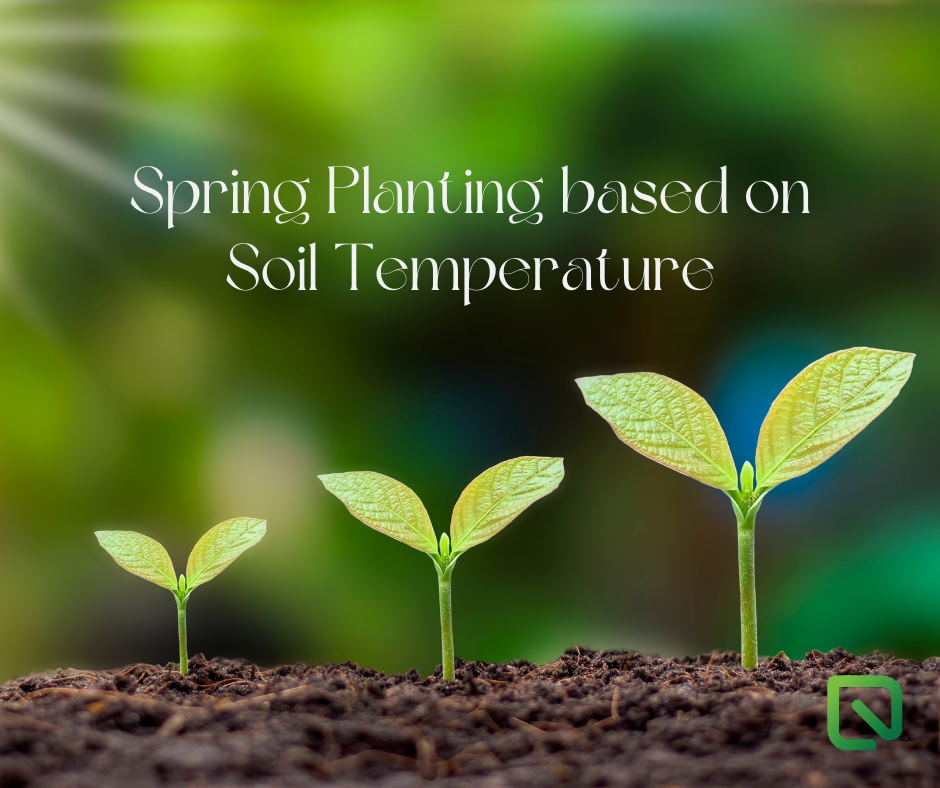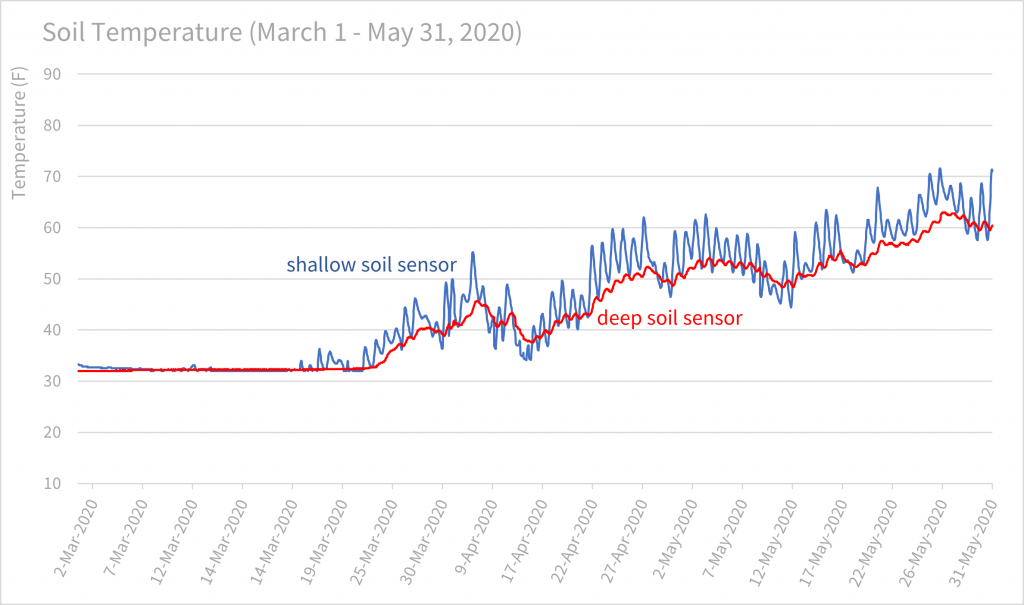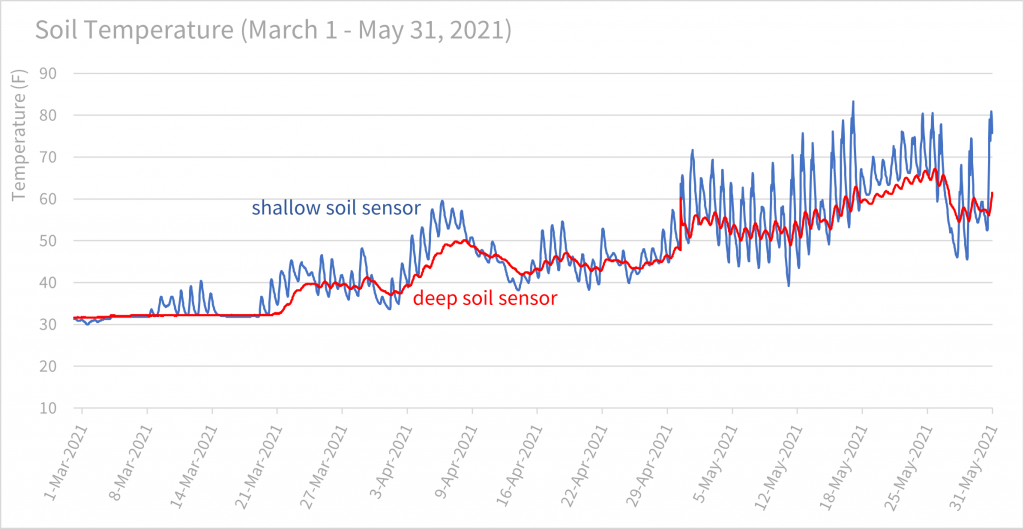Spring is right around the corner, which means warmer temperatures and more sunlight in the northern hemisphere (hallelujah)! Hopefully all your planting equipment has gotten the attention it needed this winter and you’re ready to get back out in the field.
Before you head out to sow your seeds, it is important to consider environmental factors that will give your seed the best chance to successfully germinate, soil temperature being our focus here.
First, we will look at what factors may be affecting your soil temperature (solar radiation or other biological factors).
Factors Affecting Soil Temperature:
- Solar Radiation– this is the most obvious reason that air and soil temperature rise and why soil temperature is higher year-round in geographical locations close to the equator. If you are tracking solar radiation, you know if the sun is increasing your soil temperature, or if there are other biological factors at play.
- Weather Events– Weather events such as warm/cold fronts and rain can affect soil temperatures.
- Residue in the Field– Residue (mulch, cover crops etc) on the soil surface acts as an insulator and keeps the soil cool and shielded from the sun, slowing down the warming process. Residue also holds water and keeps the soil moisture longer than a field with light residue.
- Organic Matter– an increase in soil organic matter darkens soil and increases the structural composition of the soil, therefore increasing water retention and temperature. This happens through a decomposition process that creates and retains heat.
- Compost/Manure– The presence of compost or manure on a field increases soil temperature because it stimulates a microbial, decomposition process that releases heat as a byproduct.
- Soil Moisture– Water is an insulator, therefore greater soil moisture reduces extreme temperature fluctuations in the soil. The insulting effect of water works in two ways, first absorbing daytime heat (release slowly over the night) and then protecting against night-time freezes. Both actions, which are more pronounced with increased soil moisture, reduces cold stress on young plant roots.
- Soil Color– darker colored soils typically warm up faster than lighter colored soils due to increased absorption of solar radiation. Organic matter, manure and compost can also darken the soil and/or soil surface.
- Soil Texture– Soils with a sandier texture are more porous and tend to dry out faster than heavier clay and loam soils. Sandy soils also experience larger variations in soil temperature depending on above ground solar radiation and weather conditions.
- Time of Day– Soils are usually coolest in the early morning. Each individual field will warm up differently than one another depending on residue, soil color and topography (position and slope of the land changes the angle at which the sun reaches the soil), they will not all warm the same.
These factors and how they affect soil temperature are very complex. With the help of annual, year-round soil temperature and moisture data combined with climate data, you increase the ability to understand how your soils are reacting to various farming practices and conditions.
Tips for Using Soil Temperature Measurements for Making Planting Decisions
- When considering soil temperature for planting, it is best to consider a three-day average of soil temperature. This will account for temperature swings from daytime to nighttime, as well as temperature fluctuations from day to day. There can be large fluctuations in temperature close to the soil surface, so taking an average temperature over at least three days will help reduce risk.
- Look at the weather forecast for the next several days before and after planting. If seeds are planted and cold wet conditions are forecasted it is best to delay planting until soil temperatures rise and there is little to no chance of soil temperatures falling below 50℉ for the next 3-5 days. This will give seeds a long enough window of time to successfully germinate with minimal damage.
Ideal Planting Conditions
Biological activity in soils occur most efficiently between 50-75 degrees F, and these conditions are most beneficial for seed germinations, as well. There are various seed varieties that are more tolerant to cold soil temperatures than others. It is recommended to start planting your cold tolerant varieties first and end your planting season with the least cold tolerant varieties unless your agronomist advises differently for specific reasons.
Consequences for Planting Too Cold and Wet (Corn & Soybeans):
It is important to remember that when seeds are planted, they will start a process called imbibition which is when the seed will start to absorb (or imbibe) water.
With corn, imbibitional water uptake happens in the first 48 hours after it is planted and for soybeans this happens in the first 24 hours after planting. Corn seed will absorb about 30% of its weight in water in those 48 hours and soybeans around 50% of its weight in water in about 24 hours.
If cold wet conditions occur during those windows of imbibition it can lead to imbibitional chilling of the seed. This chilling can cause cell membranes of the seed to be damaged and “leak” contents of the cell and sugars which provides a food source for pathogens.
Imbibitional chilling can result in uneven stands, seed death, leafing out underground or corkscrewed mesocotyls.
Disease & Pests:
Planting into cold wet soils slows root development and leaves the seed vulnerable to root rots and pathogens that cause diseases like sudden death syndrome (SDS), pythium, and phytophthora. These fungi are oomycetes and produce zoospores that swim in the soil water to the roots and infects the plant. They prefer cool, wet weather and soil conditions. Stressed and slow growing plants are much more susceptible to disease infection.
If there is a delay in germination and the seed is below ground for a prolonged period it also becomes susceptible to feeding by insects such as wireworms, seed corn maggots and white grubs. There are many seed treatments available to help reduce these risks.
How Can EarthScout Help Make Planting Decisions?
EarthScout soil sensors can help you with successful germination by measuring the soil temperature of the ground you are planting into throughout both the daytime heating and nighttime cooling in the weeks leading up to your usual planting dates.
When you have EarthScout units installed in your field, the EarthScout app allows you to access your field data anywhere, anytime. You can decide to prolong your spring vacation or hurry back home without even turning on a computer.
By measuring soil temperature with EarthScout, you not only know when to safely plant each Spring, but you can also track your soil health over time by comparing annual data based on your agricultural practices (minimal tillage, cover crops, crop rotations, nutrient management practices etc).
Sustainable soil management practices help stabilize soil temperature and moisture when extreme weather conditions are present and climate shifts occur.
The way you manage your fields will influence how your soils warm up in the spring, you can track these conditions each year using EarthScout soil sensors.
Instead of taking time to hand check fields with a soil thermometer, use EarthScout to monitor soil temps throughout the spring warm-up, in real time from anywhere using the EarthScout app.
Utilizing EarthScout to Plant at the Right Time
Take a look at this soil temperature data (above) collected by the same EarthScout unit over two years in the same location near Minneapolis, Minnesota. The blue line represents the soil temperature at the shallow soil sensor (2 inches deep) and the orange line represents soil temperature at the deep soil sensor (8 inches deep).
As expected, the shallow soil temperature fluctuates more dramatically in the spring compared to the deeper soil temperature. We can also see multiple “false springs” in 2021 compared to 2020. This probably occurred as warm fronts were moving through the area thus affecting soil temperatures. In season you may not know when you are experiencing a false spring or when a cold snap might come through, but you can compile and record your soil temperature data over multiple years to find a safe planting timeframe for your specific location.
EarthScout Testimonial:
Joel Dorn farms with his family in the Nicollet County area of Minnesota. He installed EarthScout soil sensors in December of 2021, to monitor soil moisture and temperature over winter and into Spring of 2022. Joel says, “I have been using EarthScout to monitor the warming spring soil temps at the 4” and 8” depths. I’ve been impressed at the differences between the temps at these depth levels and monitoring the soil frost levels.”
Joel also finds it convenient to check his soil temperature data remotely on the EarthScout App, having visibility as to what is happening in his fields when he can’t be there to scout in person every day. Historically, Joel has referenced spring soil temperature information from another county approximately 50 miles away (the closest public soil temperature records available), but EarthScout data will be a more accurate representation based on their soil management practices and soil type.
For more information about how EarthScout can help you make decisions that can save you time and money, visit EarthScout.com, or contact an EarthScout representative today at 877-443-7632.
Anna Kelley is a Technical Agronomist for EarthScout. Anna is a graduate of Northwest Missouri State University with a degree in Agronomy and GIS with an emphasis in precision ag. Her specialties at EarthScout include grain crops, irrigation management and precision ag.


